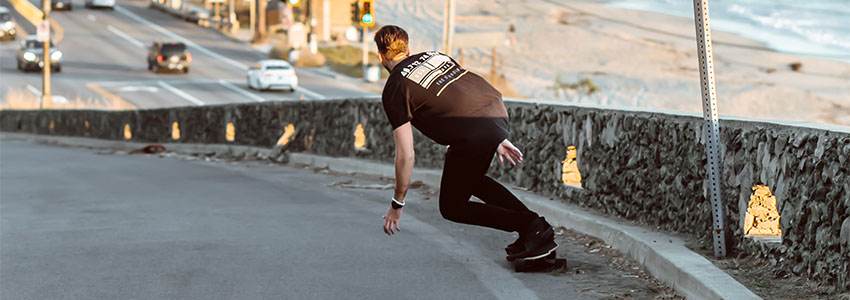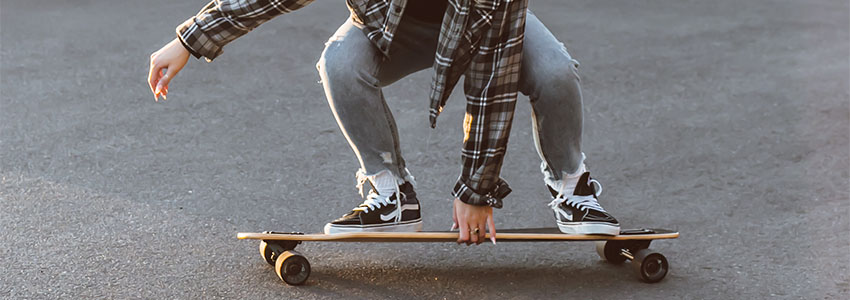How to Longboard for Beginners: Tips and Tricks
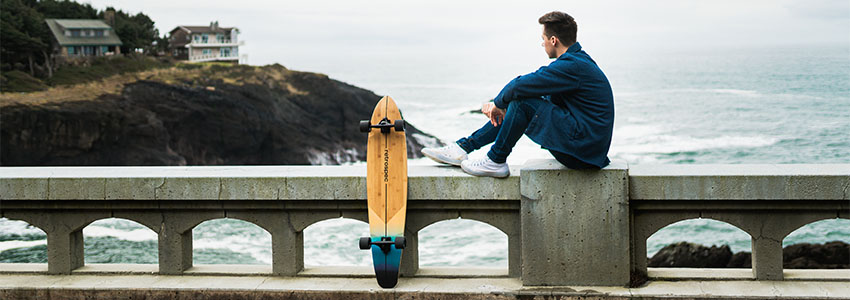
The beauty of longboarding is in how elegant and easy it looks. Longboarders carve large, sweeping turns and bomb gigantic hills with the apparent ease, but it can't be that simple, right?
Is longboarding simple to learn? In a sense, yes, but is it easy to master? No. You can learn all the fundamentals you need to go longboarding in a week or so, but it takes a lot of time, practice, and failure to master them.
So where should you start, if you're a beginner looking to get into longboarding? We put together this easy guide to introduce you to the basics of cruising. Let's dig in.
How to Longboard, in A Nutshell
As we mentioned already, longboarding looks deceptively easy. That's because the basic principle is easy to learn. Before you start riding your board down on a hill, there are some things you need to know to learn about how to ride a longboard.
Always wear a helmet!
You should always make sure when you’re starting out that you are wearing a helmet. Helmets that are CPSC tested and provide full-formed protection are the way to go. Check out some of our best-selling skate helmets here.
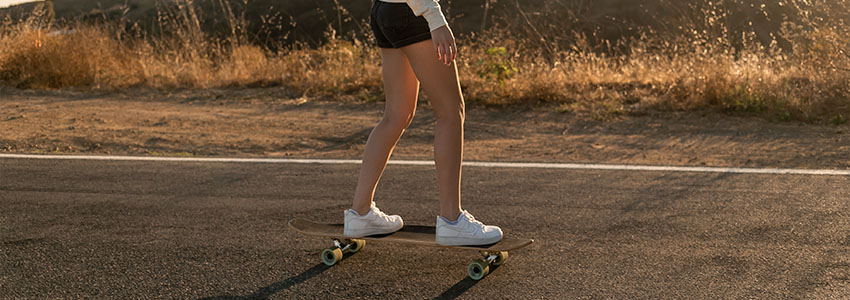
Stance and Foot Placement
Step one: put your front foot forward—but which is your front foot? Foot dominance is like hand dominance. When you stand on the board, it should feel more natural to put either your left or right foot forward. Try it both ways and see which is more comfortable.
We call these stances "regular" (left foot forward) or "goofy" (right foot forward). On average, right handed people tend toward a “regular” position, while left handed people typically tend toward a “goofy” position. Ultimately, however, it should all come down to what feels most comfortable for you.
When you put your feet shoulder width apart on the board, your front foot should be pointed diagonally forward and your back foot should be parallel with your back truck. Keep your weight on the balls of your feet and practice pivoting and leaning side to side. The easiest way to practice this is with your board on a flat surface where it can't roll, like grass.
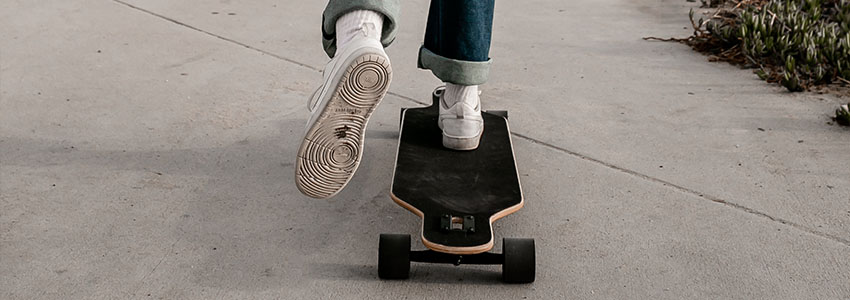
Pushing and Balancing
When you have a feel for standing and balancing on your board, put it on flat pavement and try it at a slow roll. First, stand on your board normally. Then, shift your weight to your front leg, take your back foot off the board, and push with it.
Start slowly until you become more confident. Bend your knees a little and keep more weight on your front foot. Try to keep your movements smooth and fluid, especially in the beginning.
Hopping Off (Without Getting Hurt)
Okay, so you're rolling, but now, how do you stop? At low riding speeds, you can try one of two things. The easiest is to hop off your board. Set your back foot down like you're going to pump, and then just take your front foot off the board and walk away.
But it's also good to practice braking at low speeds. Braking means setting your back foot on the ground lightly, as if you were going to push. But rather than pushing, drag it along the ground to slow yourself down. This is one of the three main ways to slow down on a longboard, and a good one to know at all skill levels.
Starting and Stopping
The next steps are all about momentum—how to get more and how to take a little off the top when you have too much. Tip-toe out of your comfort zone, stay in control, and go for it!
Gaining Momentum
There are a few ways to get moving faster on a longboard. One is pumping, as we've discussed. As you start getting more confident, you'll be able to pump more aggressively. If you're on a hill, though, this can be a bad move. If you pump while moving too fast, you can lose your balance and fall, which is, of course, what we're trying to avoid.
At higher speeds, the way to gain more momentum is to enter what we call a "tuck". Tucking means lowering your body to the ground, with your knees bent to 90 degrees. You're going to lean your weight over your front foot with your torso pointed forward.
This stance looks dangerous, even unstable. But it's actually the safest way to take on high speeds. It reduces air resistance and gives you much more balance by lowering your center of gravity. It's a good idea to practice getting into and out of a tucked position before bombing big hills.
Learn How to Stop on A Longboard
Stopping is the most important thing to know how to do on a longboard. There are three main techniques for slowing yourself down: braking, carving, and sliding. Each of them works best at a certain speed.
For low speeds, braking is ideal. You can take your foot off the board and come to a complete stop without having to turn. When you're cruising around in low-risk settings (such as a parking lot), braking is crucial.
For more moderate speeds, carving works well. Carving means making sharp S-turns. You do this by bending your knees, leaning at the waist, and moving your weight from toeside to heelside quickly. The turns will create some friction that will slow you down. Make sure you're not going too fast, as making sharp turns at speed can cause you to fly off your board.
Different Styles to Try Out
Now that you've got a basic idea of how to longboard, you should start thinking about how you want to do it. Let's cover the basic styles of longboarding to see which fits best.
Cruising
Cruising is what most people do when longboarding. It's the most casual style and also the easiest to do. Cruising means riding around town at low or medium speeds, carving corners, and generally having a fun, laid-back ride. If you're the kind of person who wants to longboard to work every day, or go for chill rides around town with your friends, cruising is for you.
Freeride and Downhill
Freeride and downhill riding are where longboarding gets real. Freeriders longboard at higher speeds, incorporating more stylistic riding like powersliding. It's about going fast, being in control, and doing it stylishly.
Downhill longboarding takes the concept of freeride boarding to another level. Downhill riders are about one thing and one thing only: speed. This takes control, confidence, and a ton of practice. Not to mention a good helmet.
If you do intend to brave the process of learning to downhill ride and coleman slide, make sure that you have a solid helmet and slide gloves—you’ll definitely want gloved hands on rough surfaces!
Freestyle
Freestyle riding is the polar opposite of downhill riding. Freestyle is all about moving over flat ground as creatively as possible. Usually done at low speeds, freestyle riders will coast along pavement, chaining together tricks. It's almost like skateboarding, but more "flowy".
Longboarding FAQs to Consider Before You Start
How much is a longboard?
Longboards vary in price by their designs. They can range anywhere from $70 to $150 or more. Flat decks are usually cheaper, and drop-down decks are usually more expensive.
What other gear do I need to go longboarding?
A good helmet is always recommended and if you’re still in the process of getting comfortable riding your longboard, a pad set will keep you protected from any bumps or bruises.
What are the different kinds of longboards?
Longboards are usually defined by how the trucks mount onto the board. The basic classifications are top mount, drop-through, and drop-down.
How do I stop on a longboard?
You can stop on a longboard by braking with your back foot, or carving in sharp S-turns.
What are "speed wobbles" on a longboard?
Speed wobbles happen when a rider becomes unstable at high speeds. The board wobbles aggressively, which can cause the rider to fall.
Many elements go into preventing the dreaded speed wobble. One of them is practice. Practicing proper weight distribution and turning is key to avoiding serious speed wobbles.
If you’re still experiencing speed wobbles even after practicing, check to see if either your wheels or trucks are loose. If they are, a little adjusting and tightening should do the trick!



